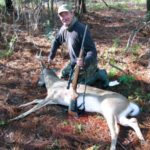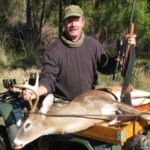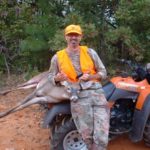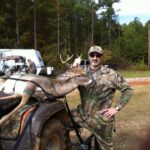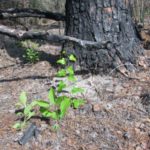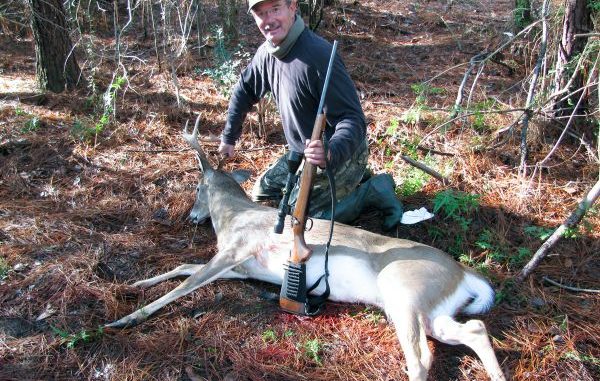
You and your buds can sit in tree stands and wait on deer to stumble by, or you can take the initiative and up your odds. Here’s how.
“You want cold for deer-hunting and wind for duck-hunting!” Artie growled. “All da rest is a buncha snake-oil and hocus-pocus by outdoor writers to sell a buncha stupid, worthless trinkets!”
Artie was in one of his moods. But he had a point (weatherwise, anyway.) And since the thermometer read 65 degrees at 7 p.m. on this December evening some spirits weren’t exactly soaring at Da Deer Camp when contemplating the morning hunt.
Not that the gabby and jovial gentlemen crowding around the Bourré table seemed the least bit discomfited by the weather forecast — nor the ones arguing the relative merits of andouille vs. tasso as a flavoring agent around the gumbo pot in the kitchen — much less the ones on the porch spraying spittle with neck and forehead veins pulsing while slamming their fists into their palms.
These latter were “calmly discussing” — what else — Les Miles as football coach.
In brief, 80 percent of the camp members seemed fine for the weekend. But the other 20 or so percent suffered from a rare affliction at Louisiana deer hunting camps. Specialists in this peculiar malady have diagnosed and defined it as “actual interest in hunting deer.”
In brief, most of us have, at most, a couple of days a week to hunt. So what are the chances that it’ll be super-cold for our deer hunts and super-windy for our duck hunts? Pretty slim actually.
But when the dates and weather fall right they create hunting memories for a lifetime of highly animated BS sessions at camps.
But usually the après hunt commentary is more along the lines of: “Dey ain’t moving — too hot!” “Dey ain’t moving — full moon!” “Dey ain’t moving — too much huntin pressure!” Dey ain’t moving — rut ain’t started yet!”
Fine — but whatever happened to making dem move? Sounds crazy, but that was the normal way to hunt deer for many (perhaps most) of our fathers and grandfathers. The notion of sitting in a tree or box stand waiting for one to haphazardly bumble along just seemed outrageously nonproductive, if not downright insane.
Dogs and drives were — by far — the preferred method of deer hunting. Dogs in Dixie and man drives in the Midwest and North.
Given the passions already unleashed while “discussing” Les Miles, many of us weren’t in any mood to discuss the former method of deer hunting (i.e., dogs). So for this visit we’ll stick to the latter: man-drives.
It used to be a deer magazine cliché, especially for hunting public land: “Let the crowds push deer to you!” headlined a couple of articles every month, in every magazine.
And the cliché has a certain merit.
Problem is, in most public areas there’s simply no way to do an “end-run” around the crowds and position yourself in a remote area as a “stander” rather than in a crowded area as a “driver.”
In our experience, Pearl River WMA provided an exception to this rule. Because of boat access this “end-run” proved eminently possible.
Look at a map of Pearl River WMA and note how the roads and trails are concentrated in the very north and northeast sections. Look just southeast of this area and you’ll find English Bayou running parallel to the East Pearl River for a mile or so before joining it.
Note the cul-de sac this junction forms. The Thanksgiving either-sex weekend crowds tend to concentrate in the north-northeast section of the WMA, and this orange invasion tends to push many deer and pigs down into the English Bayou area, especially funneling them into the cull-de sac.
Consequently, the hunting in this area (in our experience, at least) gets better as the season progresses and the pressure in northern sections pushes down the game. Coming up the East Pearl by boat to English Bayou accomplishes that all-important “end-run” positioning.
On our lease, however, one-man “drives” through the thickets, with another one (or maybe two) hunters as standers have paid off. This doesn’t mean (at least in our experience) that a “man-driven” deer will calmly traipse across a food plot or power line in broad daylight.
Instead, our “standers” sit up in their climbers on those heavily used trails we always find leading into or between thickets. You know the ones — those track-churned trails in fairly good cover where you excitedly set up a climber but for some reason (weather? late rut?) never saw the stampede of deer that the sign seemed to signal. In fact, you saw nothing!
Well, sometimes a hunter (completely covered in orange, needless to add) s-l-o-w-l-y walking and stopping in a zigzag pattern through the thicket and upwind of the stander will “drive” a deer through those trails during actual daylight.
Last year we had a chance to give this ploy a new twist.
“Bet it was that bunch from the neighboring club!” Eddie snarled, discussing a burned area we’d discovered on the far end of our lease. As usual, Eddie was trying to upstage Artie, who frowned while reluctantly ceding his place at the camp pulpit (just below the TV megascreen) after bellowing his famous axiom on hunting weather and the Mr. Haney-like attributes of outdoor writers.
“I was talking to one a dem at the Wag-A-Sack the other day during a beer run,” Eddie continued. “We started talking about the coyote problem. How they cleaned out all the rabbits we used to have in this area. He said he was a big-time rabbit hunter from St. Bernard (‘where things ain’t hard’). He started laughing, talking about how they used to set the marsh on fire right off Bayou La Loutre around Stump Lagoon to open up the place for rabbit hunting — then how they burned it farther out around Bay Eloi and even on Mud Grass Island to attract geese! It’s GOTTA be dat bunch who set the fire to the old clear-cut! They started it on their lease then it burned over to ours! Too bad our game cams in that area got burned up too. They probably had a buncha pics of them in the act! We’d have ‘em red-handed!”
Most of us blamed the fire on lightning. A big pine showed the marks of a lightning strike. But Eddie’s version was definitely more fun, especially on his third brewskie.
Naturally the burned area (only about five acres) was crisscrossed with deer trails. But then so were our food plots.
“Big deal!” Pelayo shrugged. “It’s all nighttime movement!”
He and Spencer determined this after setting up climbers on opposite ends and maintaining a vigil for two mornings and evenings each — and during fairly cold weather.
Indeed, a burned clear cut in the piney woods attracts deer almost like a pea or rye patch. And for the same reasons — nourishment. The burning generates new growth by clearing out the leaf and pine needle litter on the ground. It also clears out undesirable brush plants and grasses (broomsedge, wire grasses and blue stems) and replaces them with plants like beggar weeds, poke salad, greenbriar, blackberry and privet that deer prefer. Burning turns the leaf litter into nutrient-rich ash in seconds. Then the rain washes it into the soil, where it stimulates the growth of nitrogen producing plants and those more desirable for game.
It doesn’t take deer long to zero in on the tender shoots that start sprouting after a burn. But when are they here? Same as in our food plots — mostly at night.
But this “burn” presented an intriguing setting. To wit: What burned was a thicket consisting of part of a 5-year-old select cut, either “bedding area” or “travel-corridor” for our deer — or so we had determined. Several trails ran through it, but hunting within it was impossible. You couldn’t see 10 feet through the brambles of greenbriar, blackberry, privet, etc.
But AH! Now the trails clearly showed the same churning with tracks — but we could see for about 80 yards all around them because of the burn. As mentioned, this wasn’t a food plot or power line that they usually crossed or entered mostly at night; this was a travel corridor they (probably) traversed a bit during actual daytime (dawn and dusk, probably.)
In brief, in our experience deer tend to use the same trails over the years, even over the generations. What changes with hunting pressure is the time they use them: from daylight to night as the season progresses.
It’s gotten to the point that whenever I’m scouting and find good trails — or even better, good trail intersections — even if it’s an area I know I’m hunting exclusively, I immediately start scanning nearby trees for the telltale remnants of old wooden tree stands from the era when “open land” was the norm. And 90 percent of the time, I find them, even if they’re just a couple of boards hanging from a branch juncture. Which tells me that deer have been using the trails I hunt today since before the Causeway was built — at least.
Since Pelayo had just lost our bet on the Saints-Cowboys game (he bet on the Cowboys) he was tasked with “driving,” while Eddie and I perched in our climbers on the corners of the burn.
“How long can it possibly take to walk across that thicket?” I was grumbling by 8:45 — when I caught movement to my left!
I focused — and saw a strange shape that hadn’t been there before. I’d been scanning this place for going on three hours. I had the contours memorized. Now something was different. The sun was already high, the morning cloud cover had gone — so I caught the gleam of an antler!
Now the shakes started big time. But my rifle was across my lap. The little buck (looked ideal for fajitas and venison Parmesan!) was rock still — as was I. He moved back into the thicket so I s-l-o-w-ly started bringing the gun up. With my elbows on my lap, I finally steadied the scope.
A 4-point at least — maybe a 6.
“Deep breath now,” I advised myself — just as the deer started walking, following the edge of the burn. I was a basket case.
Then he stopped — and looked straight at me from a distance of maybe 80 yards. A classic standoff. A second ago I described him as “a shape that hadn’t been there earlier,” and he probably thought the same about me, 23 feet into this black gum and with very little leaf and branch cover around me.
“Good heavens!” I said to myself. “He ain’t gonna stand there forever!”
The crosshairs steadied on the juncture of his neck and shoulder. I started squeezing ….
PE-TOW!
He collapsed and started kicking — kicking — kicking. Leaves and mud going everywhere.
“Will he get back up? Did I just stun him?” I wondered while shakily cranking in another round. Then I focused through the scope and saw his tail give those last few shakes and quivers.
Nope. No need for another shot.
Amigos, is there a more glorious feeling afield!
Pelayo and Eddie waited all of 60 seconds after the shot before texting me.
The mud in bottoms captures every deer track and keeps them fresh looking for days. Most deer don’t actually travel in the bottom itself. It’s just that the relatively few times they do they leave such pretty tracks. Most deer trails run parallel to the bottom but halfway up the ridge from it.
Also, the few white oaks that grow in this type of timber are usually on the ridges. And we all know about white oak acorns. Tracks don’t show up so nicely on these leaf-carpeted ridges, but if you look closely you’ll usually find browsing sign and droppings in a semblance of a pattern along a semblance of a trail.
Hunting up here gets you away from the crowds and on the better traveled deer trails.
Oh, and Pelayo nailed one the following week, a nice 5-point. But he shot it over a rye and clover food plot. That doesn’t count.
